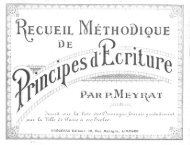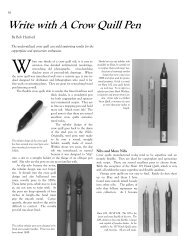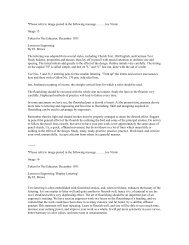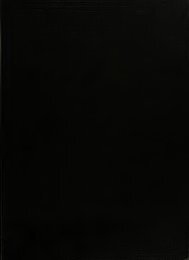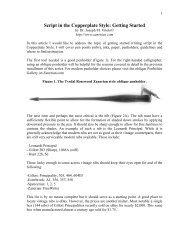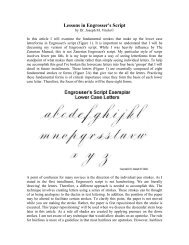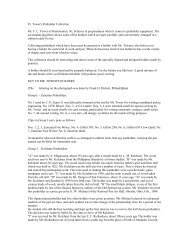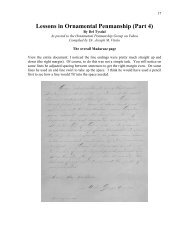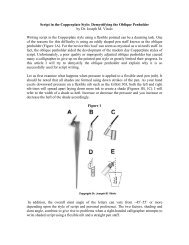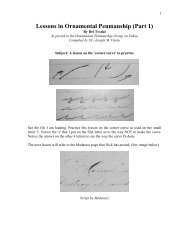The Educator (Volume 45) - IAMPETH
The Educator (Volume 45) - IAMPETH
The Educator (Volume 45) - IAMPETH
You also want an ePaper? Increase the reach of your titles
YUMPU automatically turns print PDFs into web optimized ePapers that Google loves.
16<br />
In Other Subjects<br />
"<strong>The</strong> children seem to realize that<br />
to receive recognition in writing,<br />
there must be a decided similarity<br />
in the work of the writing- classes<br />
and that of the other subjects. Spelling<br />
papers are quite often compared<br />
with the writing specimens. In the<br />
spelling notebooks, legibility and correct<br />
spelling are important. If the<br />
pupil has done exceptional work in<br />
the notebook, the word 'NEAT' is<br />
.stamped on the page."<br />
Miss Neff's Project<br />
<strong>The</strong> third project was submitted by<br />
Miss Ethel L. Neff, a teacher in the<br />
west Newton Schools.<br />
"What do pupils gain in penmanship<br />
from penmanship drills? What<br />
is their attitude toward such drills?<br />
How can penmanship drills be made<br />
an interesting part of the classroom<br />
procedure? <strong>The</strong>se are a few of the<br />
questions often asked of, and sometimes<br />
by, penmanship teachers.<br />
Utilizing Your Hobby<br />
"Every teacher, I believe, has a<br />
classroom hobby. My belief that<br />
practically all children respond to the<br />
beautiful, and that color plays a<br />
paramount part in their likes and<br />
dislikes, has caused me to believe<br />
that penmanship is much more easily<br />
taught, and results are better, if the<br />
student can use his knowledge of<br />
penmanship to satisfy his artistic<br />
sense. My schoolroom hobby is my<br />
attempt to produce projects, artistic<br />
in their nature, that require the use<br />
of all the penmanship skills.<br />
Colored Inks Help<br />
"Most children are not particularly<br />
impressed by our oratorical discussions<br />
on the values of systematically<br />
conducted movement drills as good<br />
limbering up exercises to get wrists<br />
and arms relaxed for the free-flowing<br />
writing we hope will follow. But<br />
when these same children are given a<br />
bottle of brightly colored ink and an<br />
example of the various combinations<br />
of movement drills arranged into<br />
flower designs, geometric designs,<br />
and even their favorite funny paper<br />
and story book characters, then one<br />
wishes the writing period were an<br />
hour long or that one's schedule included<br />
only art and penmanship. <strong>The</strong><br />
child's enthusiasm is unbounded. He<br />
knows then and there that he can do<br />
a piece of work as good or perhaps<br />
better.<br />
"Of course, teachers of penmanship<br />
know that not all children are physically<br />
able to do all their enthusiasm<br />
tells them they can do. <strong>The</strong>ir nervous<br />
make-up prevents their making<br />
a piece of work equal to that of their<br />
more relaxed and calm fellow students,<br />
but it is surprising what progress<br />
they can make in that direction,<br />
when given the opportunity.<br />
"Being the teacher of four diffei-ent<br />
grades in penmanship, I have always<br />
been accustomed to showing the projects<br />
made by the upper grade classes<br />
<strong>The</strong> <strong>Educator</strong><br />
to the lower grade classes. I have<br />
found it to be universally true that<br />
the first question to be asked is,<br />
'When can we make a project like<br />
that?' This is sufficient motivation.<br />
Every child knows that when his<br />
writing reaches such proportions, he.<br />
too, will be given the opportunity to<br />
produce such a piece of work. Children<br />
often plan for months what they<br />
think would be a project that would<br />
be unique, original, and possible of<br />
achievement.<br />
Snow White and the Seven Dwarfs<br />
"When our project was decided upon,<br />
we selected the characters to be<br />
pictured and appointed three students<br />
to condense the story to a length to<br />
comply with the ten characters to be<br />
portrayed. Each student, who had a<br />
character to design, selected the color<br />
and type of drill best suited to his<br />
character. He had to have a clear<br />
mental picture of what his completed<br />
product would be before he put one<br />
Make handwriting interesting<br />
by correlating it with<br />
other school subjects.<br />
stroke on paper because no design<br />
was to be re-done and no design was<br />
to be practiced in its picture form.<br />
This entire booklet with the exception<br />
of the last two pages of handwriting<br />
was done in the class period over a<br />
period of two weeks and no page was<br />
re-done. May I here say that of the<br />
fourteen pupils who took part in this<br />
project, four were left-handed and<br />
the only left-handed pupils in the<br />
room. I have never found a lefthanded<br />
student inferior in this respect<br />
to the right-handed student.<br />
In fact, the writing of the entire<br />
story was done by a left-handed<br />
pupil.<br />
Silent Challenge<br />
"And now, to answer the question<br />
of the attitude of the child once he<br />
has entered upon the project. <strong>The</strong>re<br />
are few students who when shown<br />
the work done by the same class of<br />
a previous year, do not feel the challenge<br />
to do something as good or<br />
better. It would be a falsity to say<br />
that all students do such projects<br />
with the same degree of enthusiasm<br />
or for some reason. Some, of course,<br />
do not want to be out-skilled by previous<br />
classes; others do it and do<br />
their best because the teacher has<br />
asked them to cooperate in the project,<br />
and still others desire to test<br />
their skill over such a large unit of<br />
work. Regardless of the reason, all,<br />
at the conclusion of the work feel a<br />
sense of pride when praise is given,<br />
and all feel definitely pleased that<br />
they have done a good piece of work<br />
with no repetition and with the least<br />
l)ossible error.<br />
"I have been, at times, amazed at<br />
the type of pupil who attains a high<br />
degree of accuracy and skill in penmanship<br />
drills. When a sixteenyear-old<br />
eighth grade pupil, otherwise<br />
a poor student, turns in a design<br />
so uniformly beautiful and expresses<br />
a desire to take it home to<br />
show his mother before it is handed<br />
to the supervisor, then all doubt I<br />
may have as to the possible value of<br />
such work vanishes. When the supervising<br />
principal, viewing such<br />
projects, exclaims 'Did student "A"<br />
really do this?'<br />
"Most teachers, I believe, feel that<br />
boys are a little less inclined to see<br />
the value of good writing in the same<br />
light as girls. When the writing period<br />
features project work occasionally,<br />
and when supplementary work<br />
of the pupil's own choice and planning<br />
is given several periods a month,<br />
then I feel that the interest in penmanship<br />
is just as keenly felt by the<br />
boys as by the girls. Some of the<br />
most proficient penmanship drills I<br />
have ever supervised have come from<br />
the pens of boys, and they are always<br />
just as eager for a superior product<br />
in this respect. Most boys, I believe,<br />
make more perfect designs than do<br />
girls, once they are convinced of their<br />
talents. <strong>The</strong>ir desire for a neat, wellplanned<br />
piece of work, and their patience<br />
in materializing what they<br />
have in mind, always lead to work of<br />
which they can be justly proud."<br />
In Conclusion<br />
May I state that the teacher is always<br />
the determining factor in the<br />
development of attitudes. For several<br />
years, my duties required that I<br />
visit the classes of a certain teacher.<br />
Upon entering the room, I was always<br />
greeted thus, "Here are our<br />
specimens. <strong>The</strong>y're simply awful!<br />
etc., etc." And they were! <strong>The</strong>n her<br />
place was taken by a teacher with<br />
far less experience in terms of years,<br />
but whose desire to help her pupils<br />
was both enthusiastic and delightful.<br />
Imagine my great pleasure when upon<br />
my first visit to her room, she<br />
said, "Here are our specimens. I<br />
think the pupils did very well." And<br />
they did!<br />
When one of m-y own childi-en<br />
comes to me and says, "Daddy, in<br />
this arithmetic problem, am I supposed<br />
to multiply or divide?", I<br />
must not immediately assume that<br />
her teacher is at fault or that the<br />
current method is wrong. It is then<br />
my turn to help in the process of<br />
teaching the application of arithmetical<br />
knowledge. Pedro T. Orato<br />
says "We must realize that transfer<br />
of training is never automatic unless<br />
accidentally so. For maximum transfer<br />
to take place, at least three processes<br />
should be provided: namely,<br />
experience, continuity, and reconstruction."<br />
<strong>The</strong>refore, let those who<br />
are so prone to say that our handwriting<br />
doesn't function under certain<br />
conditions and in certain situations<br />
first examine themselves, asking,<br />
"What am I doing to help?<br />
(Continued on Page 25)



